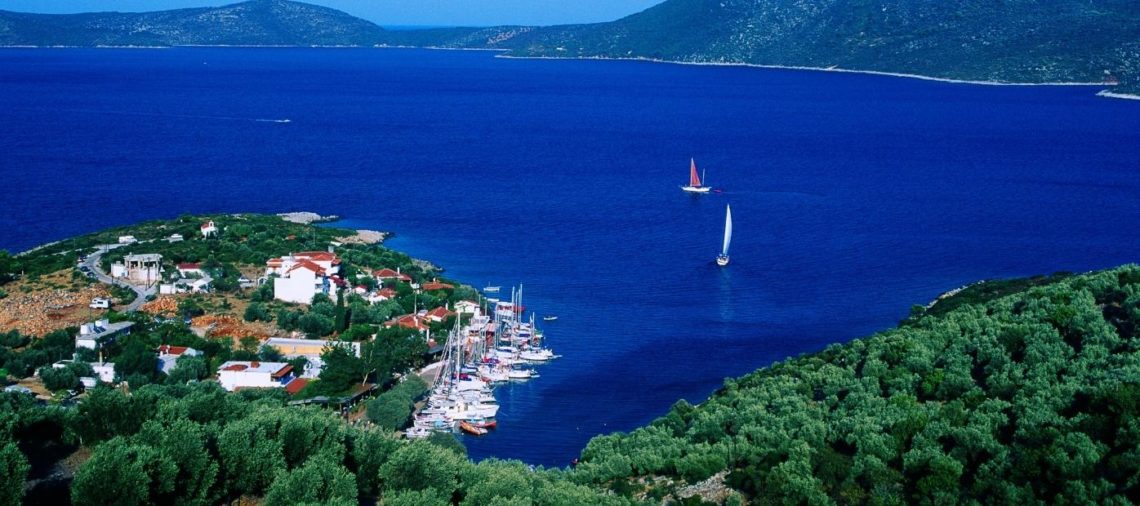Blessed with a natural landscape of surreal beauty and surrounded by the islands that dot the archipelago, Alonissos is an island in Greece which is perfect for those who want to find peace and enjoy relaxing walks through the coniferous forests, olive groves, and orchards of the region. The island is the most isolated of the Sporades archipelago. It is home to the National Aquatic Park, a haven for rare species of seabirds, dolphins, and Mediterranean seals (monachus monachus).
“Íkos”, as the island was called in ancient times, was first inhabited by Stafylos (meaning grape), son of Dionysius and Ariadne, a legend that explains the close links with viticulture since ancient times. Vessels bearing the “IKION” trademark have been exported throughout the ancient world, confirming once again the island’s fame as a wine producer.
Alonissos, the island of legends
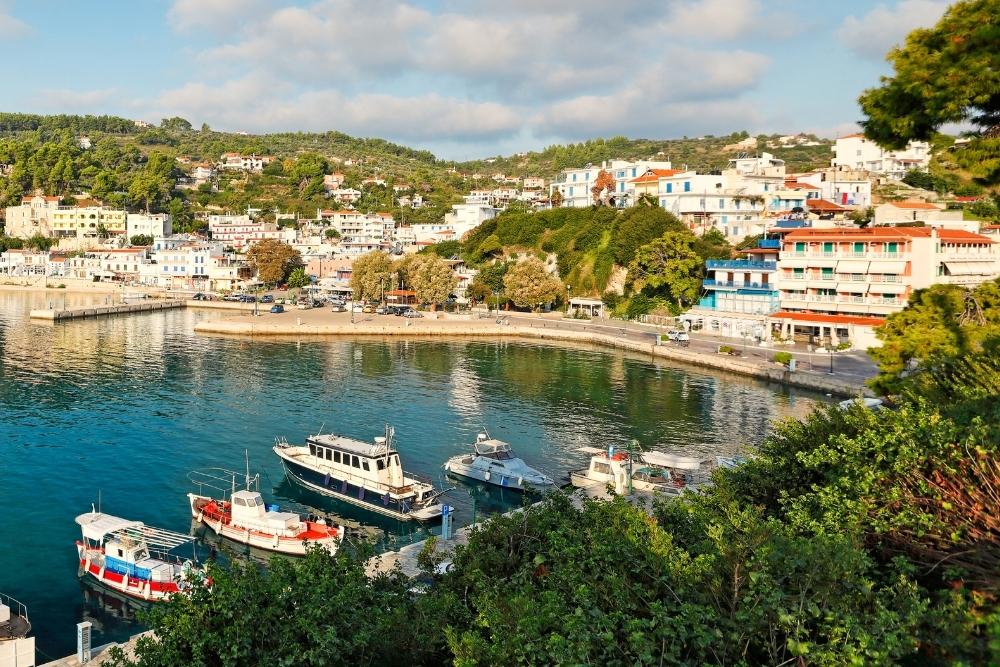
According to mythology, Pileas, Achilles’ father, was buried on the island of Alonissos. This is why the island’s second name is “Achilliodromia”. Different versions of this name have appeared over time, such as “Hiliodromia”, “Liadromia” or “Diadromia”.
Alonissos was one of the first inhabited islands in the Aegean Sea, as indicated by the ruins of the Neolithic settlements discovered at Cape Kokkinokastro (which means “Red Castle”). On Yioúra Island, man’s presence was first detected in the 9th century BC, according to the discoveries from the cave of Cyclops.
Situated at the confluence of the main sea routes, this is where the ship Argo sailed from, on which Jason and the Argonauts sailed to Kolhida to recover gold wool. Also, from here, the ships of the Athenians sailed to Troy. The numerous wrecks dating back to Byzantine times lying on the seabed confirm the island’s naval power throughout the ages. Travelers to these places, including Buodelmondio in 1420, noted that the inhabitants here were experienced sailors who used various signs to guide their ships.
Patitiri, the official capital of Alonissos island
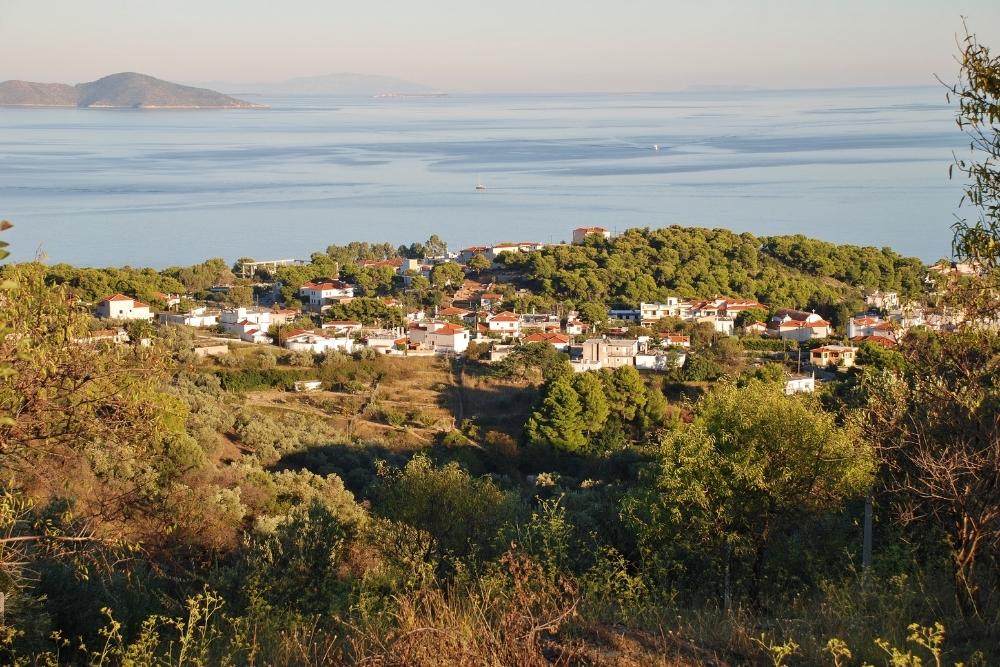
Before exploring the island, you’ll stop off in Patitiri, the picturesque harbor and official capital of the island, with its cobbled seafront, named after the wine presses used by the locals, whose main occupation was viticulture.
A relatively new village, Patitiri was built by people who fled their Chora village after the 1965 earthquake. As a result, all the homes in Patitiri are well-kept, with beautiful flower balconies and colorful verandas.
A unique harmony is created between the buildings and houses built on the hillsides, while the tourist infrastructure respects the area’s natural beauty and is quite discrete. There is a particular atmosphere to this little port with its narrow whitewashed streets and stairs, which are surrounded by emerald waters shimmering in the sunlight and rocky marble formations lit at night.
Charming Chora, the old capital of Alonissos island
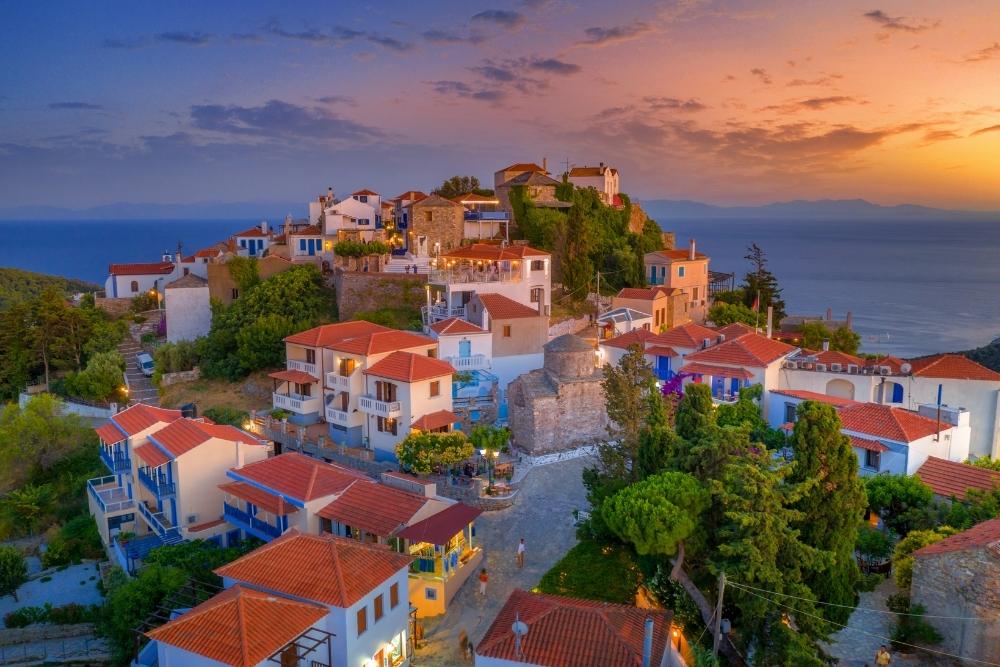
Chora (or Old Town) is the old capital of the island. The town of Chora, built amphitheatrically on the hill slopes around a natural bay, is situated four kilometers west of the port and capital Patitiri. Many of the houses in Palio Horio have been damaged, but some of these buildings were restored by Greeks, Germans, and English and are now used as cafes, local shops, or even guesthouses.
The medieval castle offers magnificent sea views, stone houses with their charming courtyards, narrow cobbled streets and fields, and the few churches bear the essence of a typical Greek island settlement.
This ancient village has winding paved alleys and steep steps lined with whitewashed houses with colorful shutters surrounded by tavernas and tourist shops.
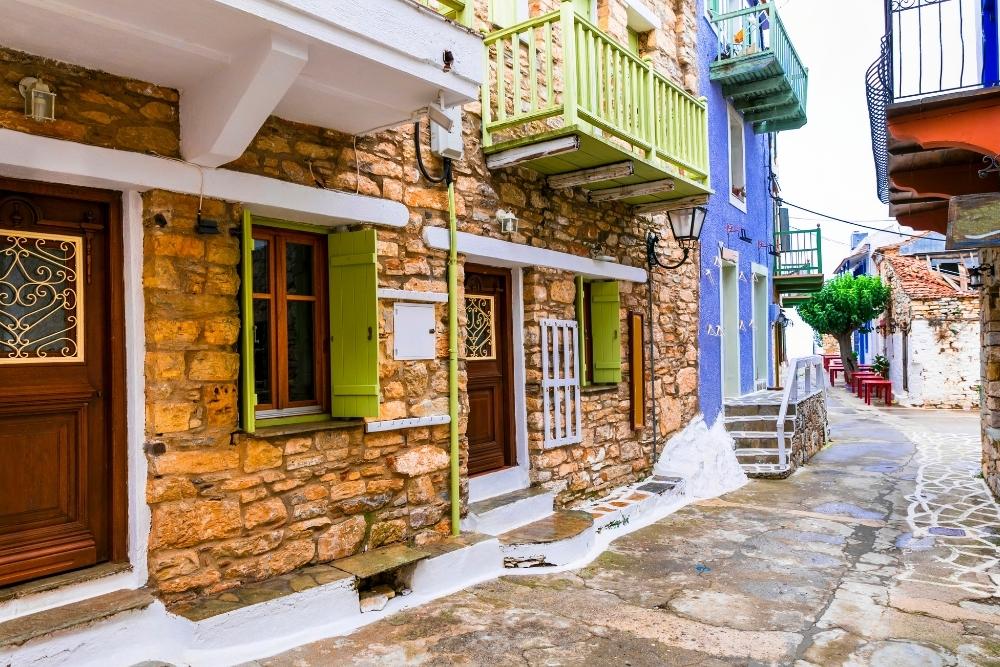
Its hilltop location provides a breathtaking view of the Aegean over the terracotta-tiled rooftops. And there’s a partially restored medieval castle to be explored as well, and complete with the remains of Byzantine walls that the Venetians restored.
From Chora, you can reach the Agios Anargyroi church, where you can take a walk in the thick coniferous forest. Its stunning location on a cliff above a north-coast beach, 4km north of Patitiri (down a dirt road), offers fantastic sea views.
At Miliá, in an idyllic location full of greenery, is the International Academy of Homeopathy, where the roots of traditional medicine, which has flourished thanks to the miraculous herbs that grow on the island, are still preserved.
Beaches of Alonissos
Sea lovers will find in Alonissos wonderful beaches, bathed by crystal clear waters, where they can spend unforgettable moments in a unique relaxant atmosphere. The most beautiful Alonissos beaches are:
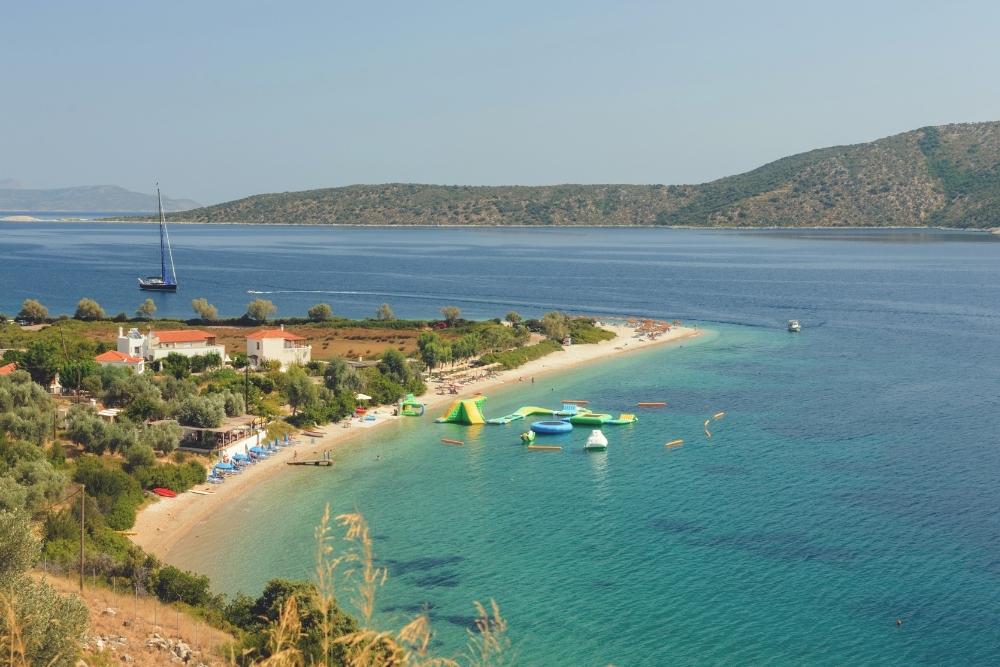
Agios Dimitrios Beach – is one of the best beaches in Alonissos, washed by the Northern Sporadic waters, which are amongst the world’s clearest waters. They are excellent for swimming and many other activities. This pebbled beach has a dramatic appearance with a horseshoe shape heading to the waters. It’s accessed by a series of crisscrossed dirt roads surrounded by chain-link fencing, which could be a bit confusing for the tourists.
Due to its beauty combined with its facilities, this beach is not considered remote or secluded, especially since its access roads have been improved. Among the advantages of Agios Dimitrios is its proximity to Steni Vala village, while Patitiri is only 14 km away.
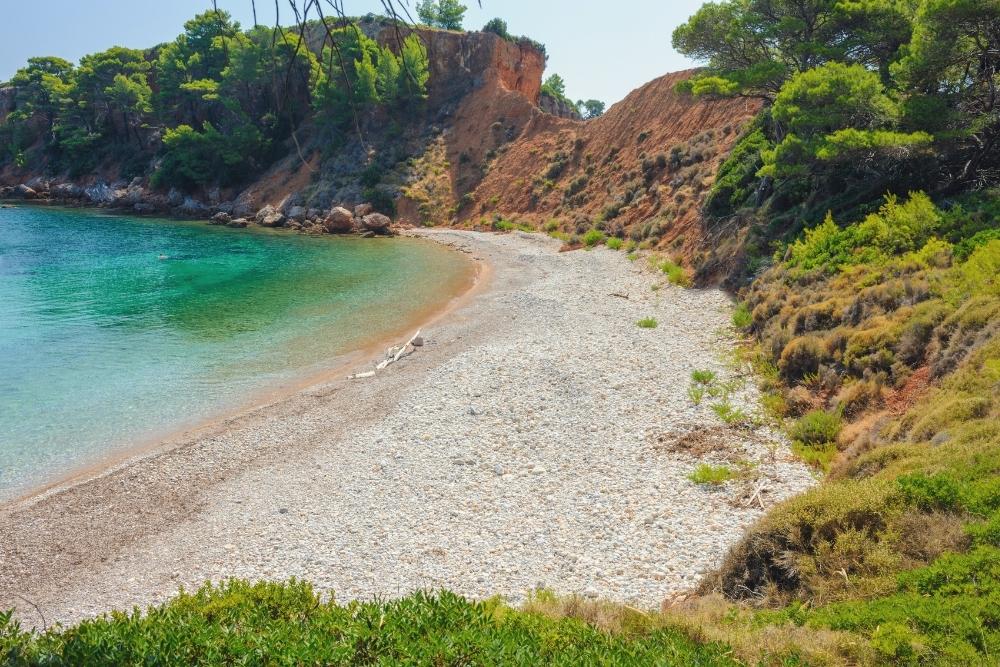
Kokinokastro Beach – Kokkinokastro (in translation “the red castle”) is a beach that lies beneath an abrupt red cliff just 7 km northeast of Patitiri. Kokkinokastro has sand and pebbles and clear, deep blue waters. A few walls of the ancient city of Ikos can be seen nearby. There were also tools from the Palaeolithic area, found on an island known as Kokkinonisi, (or Red Island). It is one of the earliest traces of human presence in the Aegean.
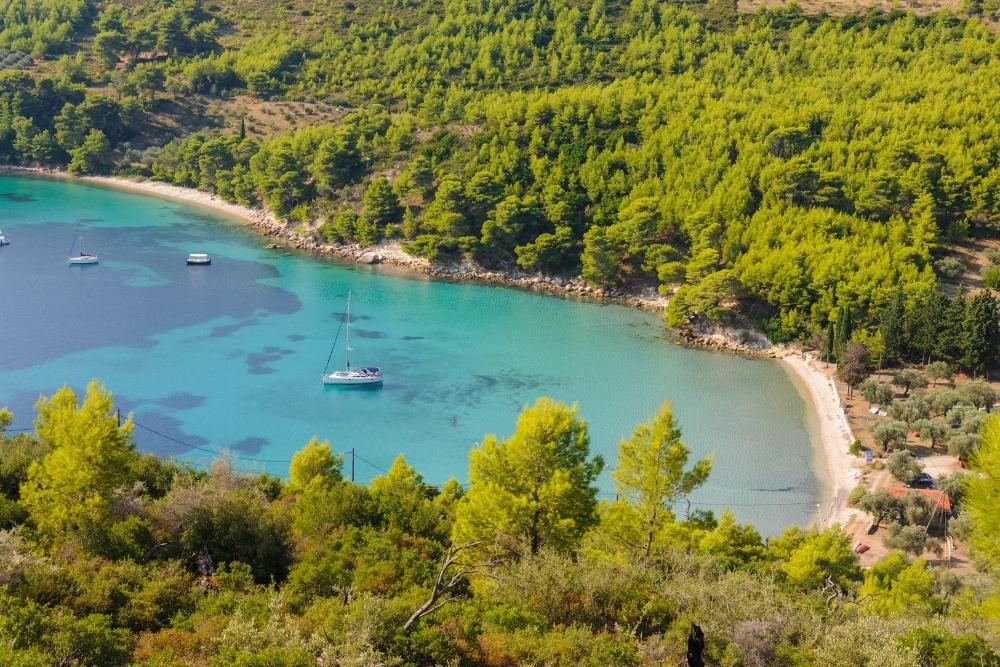
Tzortzi Gialos Beach – Several hundred meters long, this small pebble beach is protected by an inlet, and a few villas are perched above the water. It is located on the east coast of Milia.
Tzortzi Gialos is more about the water than the beach, which is narrow and uneven. There are dozens of meters of shallow water and a sandy seafloor here, like a natural swimming pool.
Many things to explore in Alonissos
Spend a day aboard a boat to explore the uninhabited island surrounding the National Park and stretching to the eastern Aegean Sea. There are 2,260 square kilometers of protected area in Alonissos, which was established in 1992 and is the largest marine protected area in Europe. The area has been protected since the 1970s for its ecological value and to protect its endangered species such as the Mediterranean Monk Seal. Living in limestone caves around Piperi, this species has a delicate habitat.
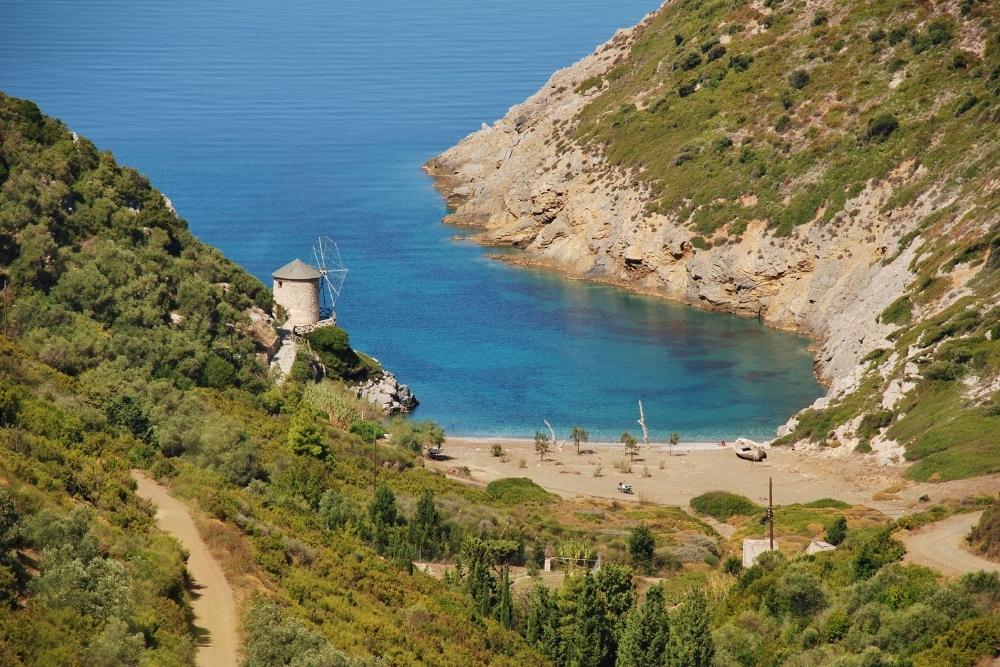
– In Yioúra, there is a cave with stalactites dating from the Neolithic period, where Homer’s Cyclops found shelter; a rare species of wild goat lives here. According to historical accounts, the cave has been uninhabited since the Mesolithic era (9-7th century BC).
– Kyra-Panagia (or Pelayoníssi) belongs to the Meyistis Lavras Monastery on Mount Athos. Here is a 12th-century monastery, one of the largest harbors in the Mediterranean, Planitis Bay, a well-preserved windmill, and an olive and grape press.
– Pipéri is the central area of the National Park, where Mediterranean seals and birds live. Access by boat here is prohibited.
– Ksiro (or Peristéra) has golden sandy beaches.
– Skátzoura is the site of the impressive Evaggelistria Monastery.
– Psathoúra is a volcanic island dominated by a lighthouse, the tallest in the Aegean; built by the French in the 19th century, it also contains the ruins of an ancient city.
Diving in Alonissos island
Even though Alonissos is a small island, there are at least four dive centers to choose from: Blue Dream, Seacolours, Triton, and Ikion. In the summer, the water temperature can rise to 26°C, and visibility is as high as 40 meters underwater.
The Gorgonian Garden holds some of the largest red gorgonians in the Mediterranean, and people who have PADI certification and drift training can explore it to a depth of 40 meters. There are fan mussels and moray eels in abundance in Blue Cave, which is ideal for first-timers and experienced divers alike.
The food of Alonissos
Enjoy the relaxing atmosphere of this dreamy island and make friends with the locals, who have kept their customs and traditions intact. Participate in the festivities in summers, such as a traditional wedding on 15 August or a battle re-enactment in July. Enjoy local specialties: cheese pie, grilled figs with honey, kakaviá (fish soup), and walnut pie.

And don’t forget to buy some “fouskakia” (traditional doughnuts), “hamalia” (wheat with a delicious filling and sprinkled with powdered sugar and almond delicacies, the so-called “amigdalota” that you can give to your loved ones when you return home.
You may also like: How to get married in Santorini

